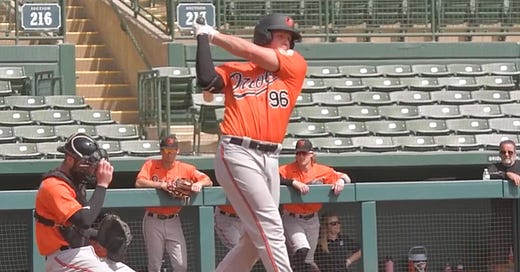The Cycle, Issue 124: Who's Next?
Ranking the 30 teams by how their top prospects placed on the top-100 lists, plus NYC lifts its vaccine mandate for athletes, 2022's new rules, my latest appearance on The Infinite Inning & more . . .
In this issue of The Cycle . . .
What You Need to Know: 2022 rules changes and NYC’s vaccine mandate
Prospect Prospectus: Compiling a master list of the game’s top prospects from the major top-100 lists and ranking the 30 teams by the results.
Shameless Self-Promotion: The Infinite Inning, episode 219
Feedback
Closing Credits
What You Need to Know
NYC’s Vaccine Requirement and 2022’s New Rules
I’m running late on this issue, so I’m not going to take a deep dive into any of the big, player-specific news items from the last week. Hopefully you’re getting the free, daily MLBTR Newsletter in your inbox every day and have already read my quick takes on such things as the Carlos Correa (Twins), Trevor Story (Red Sox), Nick Castellanos (Phillies), Kenley Jansen (Braves), and Jorge Soler (Marlins) signings, the Rockies’ head-scratching Ryan McMahon extension, Andrew Miller’s retirement, and a host of other transactions, as well as arbitration updates and injury news.
Most notable in that last category, particularly in the context of this issue, is the fact that Rays rotation prospect Shane Baz will get a late start to the season after having arthroscopic surgery to remove loose bodies from his pitching elbow. That’s not the terrible news it sounds like, however. That’s a minimally invasive procedure, and Baz was likely to have his innings limited this season, anyway. He’ll return in late May or June without having eaten up any of those innings, and thus may be able to contribute more down the stretch than he would have otherwise. Add in the fact that he got his elbow cleaned up, and it might actually be good news for the Rays both this season and beyond.
In the bigger picture, the two most significant news items from the last week are the fact that New York City has lifted its vaccine requirements for “resident” athletes and entertainers, and MLB and the Players Association came to terms on some new (and some old) rules for the 2022 season and, in one case, beyond.
The vaccine-requirement issue has more baggage than Mrs. Howell from Gilligan’s Island, but the bottom line for baseball is that Yankees and Mets players will be able to play home game this season regardless of vaccination status. However, unvaccinated players still won’t be able to play in Toronto due to the rules put in place by the Canadian government, which is far less susceptible to a behind-the-scenes pressure campaign from Randy Levine than the New York City Mayor’s Office. That’s not a problem specific to the New York teams, but it is worth noting that the restriction could be most problematic for teams in the American League East. Obviously, the Blue Jays have to make sure their players are all eligible to play in their 81 home games, but the Rays, Red Sox, and Yankees, the three teams who expect to rival the Blue Jays for the division title and/or wild-card spots, all have nine games scheduled in Toronto this season, and the absence from those games of an unvaccinated star could alter the playoff picture in the AL.
The simple solution, of course, is for the unvaccinated players to get vaccinated. Unless they have a medical condition that prevents them from doing so, they have no excuse not to. If my 12-year-old daughter, who has a fear of needles, can get three COVID-19 vaccines, a 6-foot-7 professional athlete can handle it for the sake of his own health, the health of those around him, and to set an example that will help hasten the end of the pandemic. If not for those reasons, perhaps he could be motivated by his obligation to his team and teammates. We have all (or nearly all) complied with vaccination requirements our entire lives for the sake of public health and our own. This should be no different.
As for the new on-field rules, they’re not official yet, but the owners will vote to ratify them this week, and only a simple majority is required to do so. The least controversial one concerns the active rosters. To compensate for the abbreviated Spring Training, active rosters will be expanded to 28 players in April with no restrictions on the number of pitchers. The standard roster rules—26 players with a maximum of 13 pitchers—will be back in place for the weekend series beginning May 2. That was expected and shouldn’t ruffle any feathers.
Far less welcome is the return of the automatic runner in extra innings. That is also being presented as a way of compensating for the shortened spring, as it will prevent marathon extra-inning games that could tax a pitching staff (it will, that’s true). It is also only returning for the 2022 season, for now. However, the players were the ones who lobbied for the rule’s return, and we know commissioner Rob Manfred loves it, so I wouldn’t be surprised if we see it beyond 2022, as well. I have enough anxiety about the future these days, though, so I’ll only grouse about 2022’s automatic runners for now. My objection: the battle to get on base is the key event in the game and putting a player on base automatically eliminates that. Creating a scenario in which a team can score a winning run without a batter safely reaching base is absurd and undermines the entire game. They’d be better off playing Total Bases Ball* in extras.


